St Lucia - Sun, Sand, Sea and ... Hot Sauce!
St Lucia is well known for its golden beaches, verdant rain forests and emerald waters, but not everyone dares to experience another of its offerings: something which can impart the most extreme of sensations, at least in the culinary sense. A simple bowl of harmless-looking yellow sauce, served with anything from fruit to fish, will be found on almost every table on the island. But buddy, beware: this is no mild-mannered dipping sauce. Be prepared to meet the King of Capsicums, the Prince of Peppers: all be upstanding for the Scotch Bonnet.
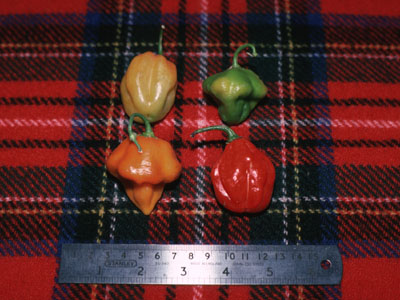
The Botanical Bit
A relative of the common sweet and chilli peppers (varieties of Capsicum annuum), the Scotch Bonnet belongs to a somewhat less widely-cultivated species, Capsicum chinense. The "peppers" themselves consist of the plant's seed pods, which are squat and gnarled, measuring some 3-4cm in diameter and much the same in length. Green when immature, their colour can be anything from a vibrant red, through mellow orange and bright yellow to an off-white when fully ripe.
The Capsicums themselves belong to the Solanaceae, an altogether notorious plant family that includes such stars as Deadly Nightshade (Atropa belladonna) and Woody Nightshade (Solanum dulcamara). Even edible members of the latter genus, such as Potato (S. tuberosum) and Aubergine (S. melongena) often have poisonous foliage, and should not be eaten when unripe.
The toxins found in most of the Solanaceae belong to a class of compounds known as "alkaloids": these are complex chemicals, many of which can be absorbed directly through the skin. It should be no surprise, then, to learn that the "hot" component of Capsicum peppers is none other than one such alkaloid, "capsaicin":
H3CO
\____ O CH3
/ \ | | |
HO-< >-C-N-C-(CH2)4-C=C-C-CH3
\____/ | | | | |
H2 H H H H
Capsaicin is among the most pungent naturally-occurring substances in the entire plant kingdom, and can be detected by humans in minute quantities: in the USA, police officers sometimes use a solution of capsaicin, as an alternative to "CS" spray, for subduing criminal suspects. Peppers, especially the Scotch Bonnet, should be treated with respect.
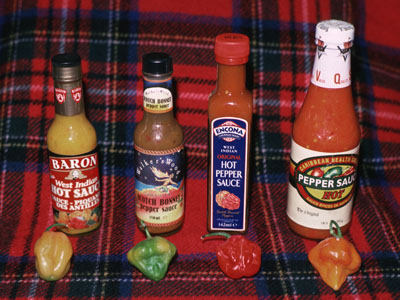
Back to Food
Unlike common chillies, Scotch Bonnet peppers combine their extreme heat with a glorious sweet fruitiness: this rounded richness imparts a wonderful flavour to all kinds of foodstuff, which is no doubt why the St Lucia islanders eat "Pepper Sauce" with virtually everything. Just a few drops adds life to a simple salad of mixed melons; a teaspoonful bestows zest upon "ground provision" (dasheen, sweet potato and other roots and tubers). Fruit, fish, meat or vegetables: whatever it is, food benefits from Scotch Bonnet pepper sauce.
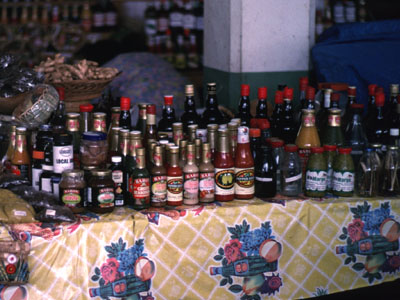
Sauce Galore
A visit to the market in Castries, St Lucia's capital city, reaffirms the predominance of the Scotch Bonnet in local cuisine. Bottles of pepper sauce are jammed, cheek by jowl, with buckets overflowing with the fresh article. As well as numerous commercial brands, there are all manner of containers, from old ketchup jars to recycled "Bounty" rum bottles, filled with enticing orange-brown, home-made concoctions.
There is considerable variation in colour, consistency and taste between different brands of pepper sauce: it is well worth buying least one bottle of each type, including a couple of home-made samples. From his most recent trip to the island, the author returned with several pints of assorted pepper sauces!
The Heat Index (#H)
In order to provide a reference point against which other pepper sauces could be measured for "heat", it was decided to include McIlhenny's famous "Tabasco" sauce in this review. Made from Tabasco chilli peppers, rather than Scotch Bonnets, its flavour is completely different from sauces made from the latter species. However, Tabasco is a sauce that can be found in almost every bar and kitchen around the world, making it a useful (and delicious) reference point: something of a "tasting benchmark". For the sake of the reviews below, the author has assigned Tabasco a score of ten, written "#10", in the heat stakes.
The Tabasco Chilli |
|
Tabasco Brand Pepper Sauce (USA, #10) |
|
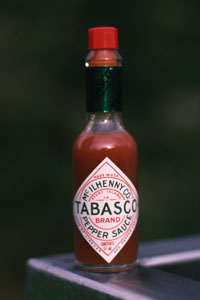 | Tabasco is made in the USA, from aged chillies of the same name, by the McIlhenny Co. It is a delicious medium-hot condiment, and is a principal ingredient of the classic "Bloody Mary" cocktail. It can be sprinkled freely on food at table, and comes in a conveniently small bottle. It included in this review as a "tasting benchmark", and has been assigned an arbitrary "heat index" of #10 (not too hot!). |
Scotch Bonnet Peppers
Now to the main business: a review of several true Scotch Bonnet pepper sauces, many bought in St Lucia's Castries street market. Others have been sourced from various UK food retailers, and originate from other parts of the West Indies, most notably Jamaica. So tasting spoon in hand, here goes...
The Scotch Bonnet Pepper |
|
Baron West Indian Hot Pepper Sauce (St Lucia, #15) |
|
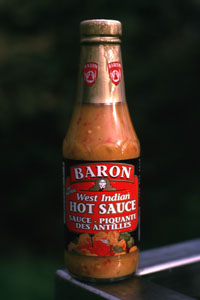 | Baron is one of St Lucia's largest food canning and bottling companies, and its famous yellow sauce is found on almost every hotel and restaurant table throughout the island. Made from Scotch Bonnets, its recipe includes mustard (hence the colour) and a mix of vinegar and other spices. It is fairly hot, thick and gloopy, with a taste reminiscent of "piccalilli" (due, no doubt, to that mustard). Splashed liberally over food, it is enjoyable, but easy-going: a good sauce for beginners. Baron also makes a red-coloured sauce which is reputedly somewhat hotter. |
Caribbean Health Choice Pepper Sauce Hot (St Lucia, #20) |
|
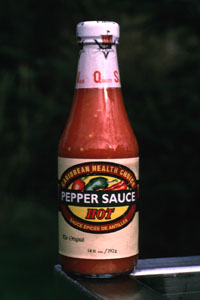 | Prepared by another of St Lucia's commercial-scale food companies, Caribbean Health's sauce looks every bit the part with its reddish-brown colour and slightly runny consistency. Deliciously fruity, it has an authentic Scotch Bonnet flavour, and can be used with abandon at table or when cooking. Caribbean Health makes several variations of its pepper sauce, given simple but descriptive names such as "Hot" and "Dam' Hot". Don't worry, the latter is not too much hotter than the former, and both are excellent. |
Classic Pepper Sauce (St Lucia, #20) |
|
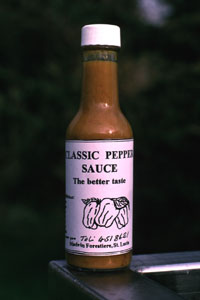 | Although produced commercially, this genuine Scotch Bonnet sauce has a distinctly home-made feel about it. The label is photocopied on paper of arbitrary colour, but don't let that put you off. A truly delicious sauce, this has a fairly runny consistency and full fruity flavour. Once again, it is fairly hot, and makes an mouth-watering table condiment. It's almost too good to cook with, especially when bought in small bottles! |
Local Pepper Sauce (St Lucia, #25) |
|
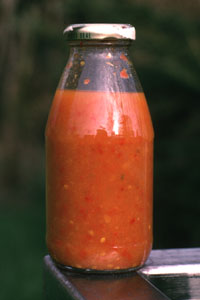 | Cooked up by the very market stallholders from which you buy it, "local" pepper sauce is made from traditional recipes involving vinegar and Scotch Bonnet peppers. Don't try looking for an ingredients list: these sauces come in unlabelled bottles that once contained milk, ketchup or rum. Orangey-brown in colour and very runny in consistency, these sauces separate out in storage, and therefore need a good shake before use. They are typically hotter than their commercial counterparts, and are full of fiery fruit flavour. Ideal for cooking as well as at table, these are thoroughly recommended, and go for a rum bottle (75cl) if you have the packing space. |
Encona West Indian Original Hot Pepper Sauce (Jamaica, #15) |
|
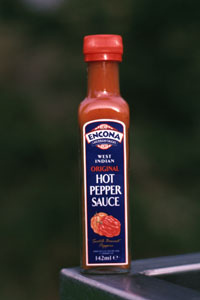 | This sauce is exported from Jamaica in vast amounts, and can be bought in decent food retailers the world over. An excellent fallback once St Lucian supplies have run out, it is distinctly red, almost ketchup-like in colour, and has medium thick consistency. Once again, it is made from true Scotch Bonnet peppers, and can be used liberally at table and in cooking. Because of its ubiquitous availability, every kitchen should have a bottle lurking on its shelves. |
Walker's Wood Jamaican Scotch Bonnet Pepper Sauce (Jamaica, #20) |
|
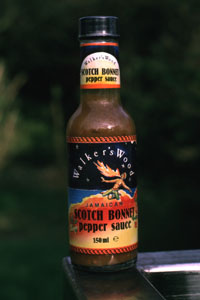 | Found skulking in the bargain basket of a UK food retailer, this sauce proved delightful. Slightly gloopy in texture, it has a reassuringly greenish-brown colour and, as its name boasts, Scotch Bonnet taste and heat. Although delicious as a table condiment, its vegetable-like colour suggests that it is perhaps more at home in the kitchen. If you can find it, buy it: you won't be disappointed. |
Chilli Vodka by Brian (England, #15) |
|
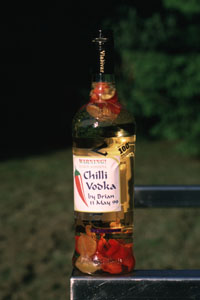 | Not averse to a little experimentation, the author has found that fresh Scotch Bonnet peppers make for the very best "chilli" vodka. Chilled and drunk neat, this is one of the most exhilarating alcoholic beverages imaginable. Full of the fruitiness that make Scotch Bonnets so thoroughly irresistible, this is also the ideal "quick fix" for a pepper fiend: vodka is an efficient solvent for capsaicin, the "hot stuff" in hot peppers, so this method of "taking the peppers" inundates the tastebuds in a tiny fraction of a second. For the constitutionally nervous, this wonderful liquid can also be used as the basis of the perfect bloody mary (sorry, Tabasco!). Sadly not for sale, you'll have to make your own (see recipe below)... |
Other Peppers
Having introduced Tabasco as a reference point in this review, the author decided to describe a number of other chilli-based sauces and products, in addition to the true Scotch Bonnet pepper sauces themselves. Having finally recovered from the Chilli Vodka, here goes...
Other Chilli Peppers |
|
Dan T's Inferno White Hot Cayenne Sauce (Canada, #20) |
|
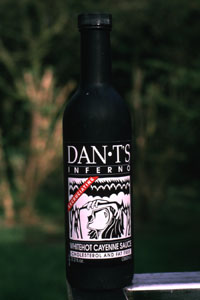 | Despite its demonic name, this Cayenne-based sauce is only moderately hot. In complete contrast to every one of the Scotch Bonnet sauces, it has a dark mysterious flavour, rather like a spicy brown sauce. It makes for a mouth-watering barbecue, spread generously over kebabs or lamb steaks before grilling, and can also be used as a dip for dim sum. This is a sauce about which there is "something of the night": dark and mysterious, and a worthy complement to, but in no way a substitute for sauces made from the Scotch Bonnet. |
Dave's Gourmet Total Insanity (USA, #99) |
|
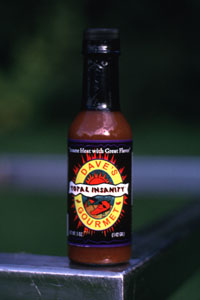 | Ouch! This one really hurts. Unlike the other products in this review, Dave's napalm-like sauce is not actually made from peppers: instead, it is made from pepper extract. It is considerably hotter than the hottest fresh Scotch Bonnet pepper that the author has ever eaten. "Total Insanity" has even been in the international news, after a school girl in Florida dared some of her friends to taste it, resulting in the need for paramedic attention! Never use this as a table condiment, but rather apply it, no more than a drop at a time, to stews and casseroles in order to impart an infernal zest. Every home should have a bottle, locked safely away from the feint-hearted. |
Old El Paso Chunky Salsa Dip Hot (USA, #1) |
|
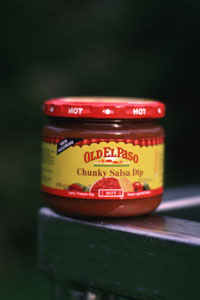 | In complete contrast to Dave's scary sauce (see above), this squat jar contains a cheerful, easy-going mix of tomatoes, vegetables and mild chilli peppers. Easy to eat in large quantities, it is a reasonable accompaniment to corn chips. Old El Paso is pleasant, but not aimed at the chilliholic: as a more exciting alternative, consider buying a can of prepared ratatouille, and mixing its contents with a good slurp of your favourite Scotch Bonnet sauce. Yum yum! |
Best Chilli Oil (China, #5) |
|
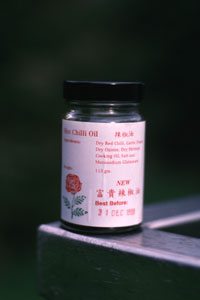 | No Chinese meal is complete without a small saucerful of Chilli Oil into which various fried objects, such as prawns and oysters, can be dipped. Made with dried chillies together with lashings of garlic and dried shrimp, the ingredients are simply mixed with vegetable oil and bottled. Each brand has a unique flavour, but not so different from its neighbours that one feels the need to buy one of each type. Reasonably hot, these oils are best used at table. Thought: must try making this stuff with Scotch Bonnets... |
Scotch Bonnet "Chilli" Vodka
A dubious reputation often precedes the drink, Chilli Vodka. When made with lesser chillies, this notoriety is often well deserved; however, when prepared from the noble Scotch Bonnet, the resulting "Chilli" Vodka takes on a unique character: rich-flavoured and full-bodied, with an all-encompassing warmth. Here's the ideal recipe:
Take around 6-8 ripe Scotch Bonnet peppers, and pull off their stalks and bracts, discarding them.
Gently tear the fruits apart, removing (and saving) the seeds. Don't cut them with a knife: this wastes valuable flavour!
Open a fresh bottle of export-strength (100 UK proof, 57% vol) vodka, and pour a small amount into a glass to make space in the bottle (don't drink it, yet).
Push the de-seeded husks through the neck of the bottle and into the remaining vodka.
Once the peppers are safely submerged, refill the bottle from the glass that you put aside earlier, leaving about 2cm of air in the neck of the bottle, and then cap it tightly.
Treat yourself to a quick slurp with whatever is left in the glass, and then place the bottle untouched in a cool dark cupboard.
Thoroughly wash your hands: if you've ever rubbed your eyes after handling Scotch Bonnets, you'll understand why. If you haven't, just take the author's word for it...
Leave the bottle for at least six weeks, by which time the liquor will have taken on a warm golden colour, and the pepper husks will have become pale.
Chill the bottle thoroughly, then open it and enjoy the best alcoholic beverage ever invented (apart, that is, from wine).
Oh, about those seeds. Plant them in some potting compost: you'll be surprised how easily they germinate, even here in England. You never know, you might even get them to flower and fruit (see below)!

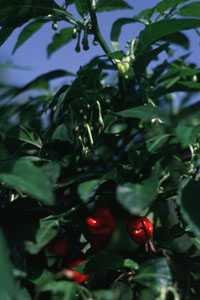
Who Rules The King?
If the Scotch Bonnet is the King of Capsicums, a little research in the market at Castries, St Lucia, reveals that he is a pretender to the throne. It turns out that, lurking in the shadows, there is a Queen: one so reclusive, that she is virtually unknown outside of St Lucia. Her slender yellow body resembles that of a Queen Hornet who has shed her stripes; her puissance more than lives up to this appearance. When Scotch Bonnets no longer cut the mustard, pay homage and devotion to the true Monarch of Mouthwatering Mayhem, her Majesty, Piment Ma Jacques.
To find out more about hot pepper sauces, check out Sam McGee's excellent website, but remember to come back here afterwards!
A really good resource, full of ideas for cooking with Scotch Bonnets, can be found at Lee Boxall's website, where as well as reading about a veritable cornucopia of mouthwatering Jamaican recipes, you can also find out about the music, arts and culture of this Caribbean island!

